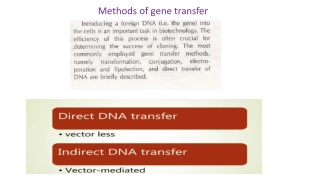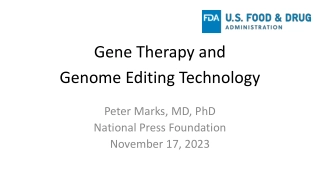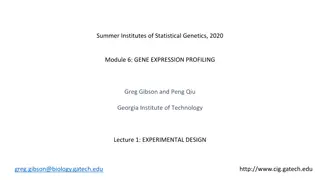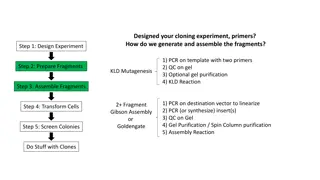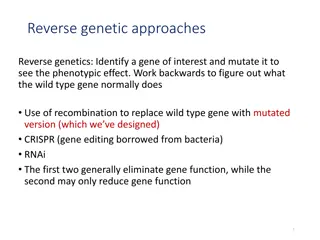Overview of Gene Transfer Methods in Molecular Biology
Explore various physical and chemical methods used for gene transfer, including electroporation, particle bombardment, microinjection, ultrasound, and bacterial transformation. Learn how DNA enters the nucleus and the role of retroviruses in gene transfer efficiency. Understand the process of RNA co
0 views • 17 slides
Gene Therapy and Genome Editing Technology
This article provides insights into the status, regulatory considerations, and delivery methods of gene therapy and genome editing technologies. It discusses approved gene therapies in the US, human genome editing in clinical applications, and the regulatory authority of the FDA over gene therapy. T
3 views • 27 slides
Understanding Gene Expression Regulation in Prokaryotes and Eukaryotes
Gene expression is a crucial process that leads to the production of functional gene products like RNA and proteins. This article explores the regulation of gene expression in both prokaryotes and eukaryotes, covering the importance of regulating gene expression, types of regulation elements, specif
5 views • 22 slides
QuickBooks License Error After Cloning A Comprehensive Guide
If you have encountered a license error in QuickBooks after cloning your system, you are not alone. This issue can cause disruptions and inconvenience in your workflow. But don't worry, we have a comprehensive guide that provides effective solutions to help you troubleshoot and resolve this problem
6 views • 3 slides
Exploring Ethical Issues in Animal Cloning and its History
Animal cloning involves creating genetically identical replicas of cells or organisms, with advancements being made in therapeutic cloning and gene cloning. The history of animal cloning dates back to the successful cloning of sheep like Dolly in 1996. The cloning procedure involves collecting cells
0 views • 21 slides
QuickBooks License Error After Cloning_ Causes and Solutions
QuickBooks License Error after cloning typically occurs due to the cloning process duplicating the unique system identifier used by QuickBooks to verify licenses. This results in QuickBooks not recognizing the cloned system as legitimate, leading to the license error.
3 views • 5 slides
Understanding Artefacts and Biases in Gene Set Analysis
Gene set enrichment tests help identify functional gene sets enriched in hit lists compared to background sets. Various biases (technical, biological, statistical) can lead to incorrect conclusions in data analysis, emphasizing the importance of recognizing and addressing them. Technical biases like
0 views • 29 slides
Exploring Genetics and Genomics in Integrative Biology
Delve into the world of genetics and genomics through the lens of integrative biology, investigating the differences between cell types, the rationale for gene expression profiling, and the analysis of differential gene expression in various diseases. Uncover the significance of gene ontology, co-ex
0 views • 22 slides
Understanding DNA Cloning with Filamentous Coliphages
Filamentous coliphages M13, f1, and fd are utilized as cloning vectors due to their circular single-stranded DNA molecules and advantages over other vectors. These phages have dimensions of 900 nm x 9 nm and infect bacteria through F pili, releasing up to 1000 phage particles per cell per generation
0 views • 17 slides
Understanding DNA Ligation Techniques for Molecular Biology Applications
DNA ligation involves joining DNA fragments to vectors to create new DNA or plasmids. Methods include DNA ligase, T4 ligase, and terminal deoxynucleotidyl transferase. Linkers and adaptors play a key role in DNA cloning experiments by generating sticky ends for DNA cloning. The use of adaptors allow
1 views • 13 slides
Understanding Recombinant DNA Technology and Cloning Vectors in Genetics Engineering
Exploring the fundamentals of recombinant DNA technology and gene cloning, this content delves into the key concepts and basic steps involved. It covers various cloning vectors such as plasmids, bacteriophages, and artificial chromosomes, highlighting their common features and applications in geneti
0 views • 12 slides
Human Insulin Gene Expression and Production
The process of cloning and expressing the human insulin gene has revolutionized the production of insulin for treating diabetes. By using genetically engineered bacteria, the human insulin gene is inserted, expressed, and purified to create insulin for therapeutic use. This innovation has overcome c
0 views • 20 slides
Gene Expression Profiling in Statistical Genetics Summer Institute 2020
This content provides information on the Summer Institutes of Statistical Genetics module, focusing on gene expression profiling. It includes details on the schedule, experimental design, RNA sequencing workflow, modes of bulk RNA sequencing, and RNASeq software. The content discusses crucial steps
0 views • 11 slides
Understanding Gene Mutations in Molecular Biology
Gene mutations play a significant role in molecular biology, leading to alterations in DNA sequences that can impact offspring. These mutations can arise spontaneously or be induced by various factors, such as mutagens. Understanding gene mutations is crucial for comprehending the genetic basis of c
2 views • 27 slides
Genetic Manipulation in Environmental Biotechnology
Genetic manipulation strategies in environmental biotechnology involve techniques like gene splicing and molecular cloning to modify genes directly. These methods have various applications such as isolating genes, producing specific molecules, improving biochemical production, creating organisms wit
0 views • 20 slides
Cloning Experiment Overview and Procedures
The cloning experiment involves designing primers, generating and assembling fragments through PCR, gel purification, and KLD reaction. Further steps include fragment preparation, assembly, cell transformation, colony screening, and working with clones. Detailed instructions for KLD mutagenesis, QC
0 views • 11 slides
Co-Developing Risk Assessments in Gene Drive
Gene drive technology is a cutting-edge approach aimed at combating malaria by spreading genetically modified genes in mosquito populations. This technology has the potential to protect endangered species and conserve nature. However, successful implementation requires complex collaborations, risk a
2 views • 16 slides
Understanding Gene Therapy: Types, Techniques, and Applications
Gene therapy involves introducing DNA into a patient to treat genetic diseases by correcting disease-causing mutations. There are two types of gene therapy: somatic gene therapy and germline gene therapy, each with different implications. Techniques such as gene augmentation therapy and gene inhibit
1 views • 15 slides
Understanding Cloning Vectors and Recombinant DNA Technology
Genetics Engineering Lecture-2 delves into the concept and basic steps of recombinant DNA technology and gene cloning, highlighting different types of cloning vectors like plasmids, bacteriophages, bacterial artificial chromosomes, yeast artificial chromosomes, and mammalian artificial chromosomes.
1 views • 13 slides
Understanding Recombinant DNA Technology and Gene Cloning
Recombinant DNA technology is crucial for developing new vaccines and pharmaceuticals by combining genetic material from various sources to create unique sequences. Techniques like transformation, non-bacterial transformation, and phage introduction are used to make recombinant DNA. Tools like enzym
3 views • 15 slides
Understanding Gene Regulation and Control of Gene Expression
This comprehensive content delves into the intricate mechanisms of gene regulation and control of gene expression. It covers topics such as transcriptional regulation, bacterial genes classification, and the role of regulatory proteins. Explore how genes are regulated at transcription, translation,
0 views • 17 slides
Understanding Gene Expression in Biological Sciences Course
Explore the dynamic world of gene expression with the Chunky and Chips Gene Expression Group at the University of Notre Dame. Dive into topics like transcription, translation, and cellular events influencing gene expression. Delve into real-world scenarios and gain insights into the cellular level b
0 views • 20 slides
Understanding Epistasis: Genetic Interactions and Their Implications
Epistasis is a phenomenon where the phenotypic expression of one gene is influenced by interactions with another gene. This concept, first introduced in 1909, plays a crucial role in genetics, affecting various traits and evolutionary processes. The difference between dominance and epistasis lies in
0 views • 41 slides
Understanding Recombinant DNA and Gene Cloning
Recombinant DNA is artificially created by combining DNA from multiple sources into a single molecule. This process involves treating DNA with restriction endonucleases, such as BamHI, which cut at specific sites, resulting in sticky ends that can base pair with complementary DNA molecules. DNA liga
0 views • 33 slides
Cloning Other Genes and Recombinant DNA Technology
The recombinant vector with a kanamycin resistance gene can be used to clone other genes by inserting human DNA fragments and selecting transformed E. coli cells. This technique has enabled the production of various human proteins for therapeutic purposes, such as insulin, growth hormones, and clot-
0 views • 6 slides
Gene Wiki Jamboree FaceBase Spring Meeting Summary
The Gene Wiki Jamboree FaceBase Spring Meeting in 2010 aimed to create collaboratively-written and community-reviewed review articles for every gene in the human genome and every concept relevant to FaceBase. It highlighted the value of such articles, providing quick summaries and compilations of re
0 views • 13 slides
Proximity Card Security_ Best Practices for Preventing Cloning and Tampering
Discover effective strategies to prevent cloning and tampering of proximity cards, ensuring your security remains intact.
1 views • 5 slides
Raw Data of Agarose Gel for Human Gene Expression Analysis
This supplementary data includes raw data from agarose gel electrophoresis showing gene expression levels for human SOX17, FOXA2, AFP, ALB, and ACTB in various cellular samples. The gel images depict the expected sizes of amplicons for each gene in different conditions and time points of cell cultur
0 views • 5 slides
Understanding Splice Sites and Splicing Elements in the Inhibitory Dopamine Receptor Gene (D2)
In this project, the focus is on identifying splice sites relevant to the inhibitory dopamine receptor gene (D2). The problem involves finding splicing elements within a specific range of known splice sites in the gene. The data provided includes the D2 gene entry in FASTA format, a database of spli
0 views • 13 slides
Understanding Reverse Genetic Approaches in Gene Manipulation
Reverse genetic approaches involve mutating a target gene to observe its phenotypic effects, providing insights into the gene's normal function. Techniques like gene knockout, knockdown, and homologous recombination are used to manipulate genes and study genetic pathways, leading to discoveries in v
0 views • 6 slides
Decoding Cloning Extinct Animals: Pros, Cons, and Methods
Delve into the fascinating world of cloning extinct animals presented by Jacob Engen and Joe Bertolini. Explore the reasons for and against reviving these creatures, alongside the challenges and methods involved in the cloning process, including the ethical implications and potential environmental i
0 views • 5 slides
Basics of Hypothesis Testing in Gene Expression Profiling
The lecture covers the essential aspects of hypothesis testing in gene expression profiling, emphasizing experimental design, confounding factors, normalization of samples, linear modeling, gene-level contrasts, t-tests, ANOVA, and significance assessment techniques. Practical insights are shared on
0 views • 9 slides
Applications of Transgenic Animals in Biotechnology and Cloning
Cloning in animals offers the advantage of indefinite duplication of elite genotypes without the genetic risks of meiosis. Transgenic animals, genetically modified to carry foreign genes, play a crucial role in genetic research and the development of livestock with desired traits. Methods like DNA m
0 views • 13 slides
The Fascinating World of Cloning: From Dolly the Sheep to Genetic Replication Techniques
Cloning is the process of creating genetically identical organisms, either naturally or artificially. This article delves into the various techniques of cloning such as gene cloning, reproductive cloning, and therapeutic cloning. It also highlights the groundbreaking story of Dolly the sheep, the fi
0 views • 17 slides
Basics of Genetics Engineering: Introduction to DNA and Gene Expression
Exploring the fundamentals of genetics engineering, this lecture covers topics such as DNA structure, gene expression, gene function, genome, mutation, recombination, and genetic modification. Understand the significance of DNA, genes, and the processes involved in gene expression. Dive into the wor
0 views • 20 slides
Understanding Expression Vectors for Efficient Gene Expression
Expression vectors are designed to facilitate gene expression by carrying essential elements such as promoters, terminators, and fusion tags. They allow precise control over gene regulation for transcription and translation in host cells, enabling efficient protein production. Different promoters li
0 views • 15 slides
Cloning the Cstps-1 Gene from Citrus sinensis for Valencene Production
In this project, the Cstps-1 gene from Citrus sinensis is being cloned to produce the enzyme Citrus Valencene Synthase (CVS) responsible for generating the fragrant valencene compound. The process involves DNA isolation from a Valencia orange, gene amplification, vector transformation, and testing f
0 views • 8 slides
Understanding the Role of Multiple Enhancers in Gene Regulation
Multiple enhancers play a crucial role in regulating gene expression in a cell, with approximately 3-5 enhancers associated per human gene. These enhancers are essential for tissue-specific expressions and are active within the same cell line. The use of multiple enhancers can impact gene expression
0 views • 30 slides
Advances in Gene Therapy Programs and Best Practices Workshop Insights
Workshop outcomes and discussions from the MDA-NINDS Workshop on Best Practices for Gene Therapy Programs, highlighting key challenges, possible solutions, and the impact on translational funding programs. The workshop format included orienting talks and panels focusing on scientific premise, regula
0 views • 17 slides
Understanding Cloning in Yeasts: Vectors and Selectable Markers
Yeasts like Saccharomyces cerevisiae and Schizosaccharomyces pombe are valuable organisms for eukaryotic gene expression. They offer easy growth like bacteria and are genetically well-characterized. Yeast selectable markers and vectors enable efficient cloning and expression of genes. The use of shu
0 views • 16 slides
